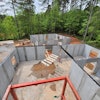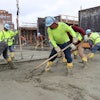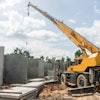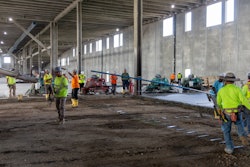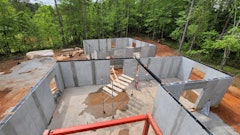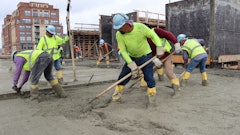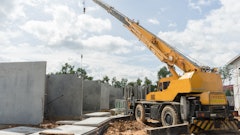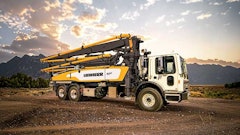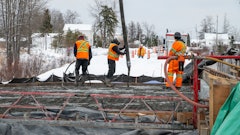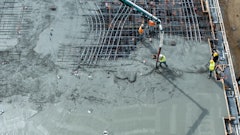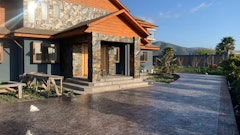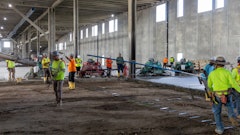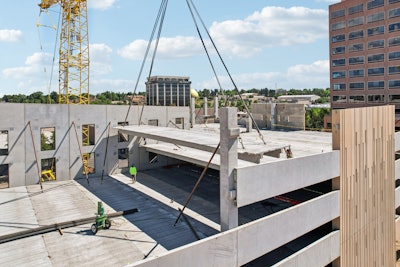
Even though it’s one of the most referenced success metrics for new construction, it’s a rare thing for a project to be completed on time. Research has consistently shown that only a small fraction of projects, often less than 10 percent, are completed on time and within budget.
Construction schedules are impacted by a range of unpredictable factors: weather delays, labor availability, permitting hurdles, material shortages, and the delicate balance of coordinating multiple trades. These challenges make it difficult, even for the most skilled general contractors, to maintain precise control over timelines. Tight client expectations and the growing complexity of modern building designs only add to the pressure.
That’s why many general contractors are now embracing methods that enhance project outcomes, increasingly turning to off-site construction — whether through prefabricated components or modular builds — to achieve those goals. While there are benefits to using prefabrication, it’s also important to understand how to discuss those benefits with partners and project stakeholders so everyone understands the impacts on project success.
While architects and owners are often drawn to the longevity, resilience, and versatility of prefabricated systems, general contractors are primarily motivated by:
- Schedule efficiency and improved schedule certainty
- Faster installation
- Enhanced quality control
- Reduced reliance on manual labor, especially amid labor shortages
General contractors often face scheduling and logistical pressures that come with managing numerous on-site trades. Once prefabricated systems arrive on-site:
- Design issues have already been addressed through delegated design, shop drawings, and BIM coordination
- The building envelope can be erected in a fraction of the time required for traditional materials, using a much smaller crew size
- Jobsite risks are reduced and safety improves, as most of the work is completed off-site in a controlled environment, often leading to lower insurance premiums for workers’ comp, general liability, and builder’s risk
Talking Point #1: Project Speed
Once the prefabricated elements arrive on site, the building envelope is typically only weeks from completion. Jobsite disruption is significantly reduced because the system requires less material staging and a smaller crew. Compared to traditional rainscreen systems — such as masonry, terra cotta, or metal panels — installation is faster and eliminates the need for exterior scaffolding.
By accelerating the envelope installation, contractors can achieve dry-in sooner, enabling interior work to begin earlier in the construction cycle and helping keep the overall project schedule on track.
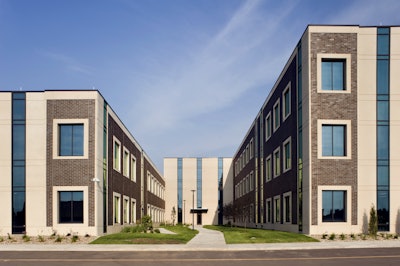 One Stop in Sioux Falls, SD, features thin brick prefabricated panels that reduced crew size and accelerated construction compared to traditional masonry.Wells
One Stop in Sioux Falls, SD, features thin brick prefabricated panels that reduced crew size and accelerated construction compared to traditional masonry.Wells
Prefabricated concrete systems often provide:
- Customized shape, form, and texture
- A wide range of colors and finishes that replicate natural materials such as brick, stone, or terra cotta
- The ability to act as a substrate for embedded natural materials
- Built-in barrier wall functionality with options for continuous pre-installed insulation, improving thermal, air, and moisture performance
- Factory-installed and sealed windows, which reduce on-site labor and ensure consistent quality
All components are shipped as a single monolithic unit, shifting the time-intensive labor of multiple trades off-site. This reduces site congestion and accelerates the overall project schedule.
Talking Point #2: On-Site Safety
Most importantly, accelerating the schedule does not compromise safety. Prefabrication field teams consist of specialized installers who are OSHA trained and certified for all relevant equipment and scopes of work.
However, lifting heavy precast pieces from trailers and positioning them with cranes carries inherent risks. To mitigate these, operations should include:
- Daily pre-task safety briefings and toolbox talks, often coordinated with the general contractor
- Regular crane inspections performed by third-party professionals
- Proper rigging procedures and equipment, with thorough inspections and clearly legible ID tags
- Consistent reinforcement of safety protocols with every lift and delivery
- Coordination with other trades to ensure controlled access zones are clearly identified and visually marked
These measures help ensure safe and efficient installation — even for large, heavy panels.
More about prefabricated concrete on ForConstructionPros.comConcrete Panels & Green Construction - Innovations in prefabricated panels are challenging conventional concrete construction. Creating Disaster-Proof Construction With Concrete, Prefab Panels - This Digging Deeper Podcast episode features co-founder Annette Rubin of Vero Building Systems, a manufacturer of a construction system aimed at using concrete and prefabricated panels to build “disaster-proof” buildings. How To Adapt Construction Contracts to Fit Modular Building - Contracts on modular jobs demand greater attention to deadlines for the deeper preconstruction workload, deciding if the factory is a contractor, subcontractor or supplier and assigning risk. |
Talking Point #3: Control
Manufacturing building components off site enhances quality control. Prefabricated panels are created by a team of specialists — skilled, certified professionals who are used to working within tight tolerances. Make sure your partner’s facilities are regularly audited, and that the quality control team documents every step. The general contractor should receive a full record of each product and panel that their prefabrication partner produces.
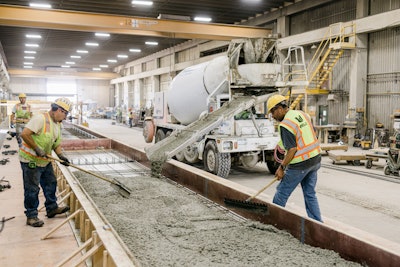 Off-site manufacturing allows prefabricated panels to be built in a controlled environment, ensuring higher quality, precision, and consistency before they reach the jobsite.Wells
Off-site manufacturing allows prefabricated panels to be built in a controlled environment, ensuring higher quality, precision, and consistency before they reach the jobsite.Wells
Working in a controlled environment also facilitates a higher level of craftsmanship. With advanced tools like automated casting systems, CNC machines, and laser-guided measuring equipment, prefabrication specialists build with precision — and that technology just keeps improving.
Quality Control team members check dimensions, finishes, and structural integrity multiple times before anything leaves the facility, so there are no surprises on site.
General contractors’ involvement during the manufacturing phase often consists of:
- Visiting the facility to see manufacturing in action
- Reviewing the fabricators QA/QC manual
- Ensuring manufacturing run panels are in line with approved samples
- Facilitating coordination mock-ups between prefabricators and other trades
- Tracking completed manufacturing for scheduling and monthly pay applications
In the end, contractors get exactly what they expect: products that meet specs, align with submittals, and seamlessly integrate with other trades.
Talking Point #4: Jobsite Management
With fewer trades required on site, general contractors benefit from increased laydown space, greater scheduling flexibility, and more efficient jobsite coordination. During facade installation, work is typically limited to a designated zone and executed by a small, specialized crew of approximately eight personnel.
Precast panels are delivered to the jobsite as needed, and aligned with the productivity rate of the installation crew and the overall construction sequence. These panels are often fully finished and function as a complete barrier wall system, eliminating the need for additional cladding trades or supplementary materials. On certain projects, this single system can provide a fully integrated building envelope that meets or exceeds performance standards for air, moisture, thermal, fire and vapor control.
 Baptist Hospital in Pensacola, FL, used a fully unitized prefabricated building envelope system that streamlined installation and ensured consistent quality across the facade.Wells
Baptist Hospital in Pensacola, FL, used a fully unitized prefabricated building envelope system that streamlined installation and ensured consistent quality across the facade.Wells
The reduced on-site labor force, combined with the proven performance of the precast wall system, means general contractors can spend less time managing multiple trades. Coordination is streamlined and typically requires the general contractor to focus on just a few key areas:
- Delivery schedules
- Site logistics and accessibility
- Crane lift plans
Talking Point #5: Costs & Responsive Design Changes
Using a precast wall panel system allows the precast fabricator to integrate into the design team early — often as a design-assist trade partner. This collaborative approach, supported by delegated design and BIM software, helps identify and resolve design changes in real time as contract documents are developed.
Key benefits of this process include:
- Early design coordination, allowing issues to be resolved before construction begins
- Timely communication of cost and schedule impacts related to design adjustments
- Panel mold optimization, ensuring efficient use of formwork and repetition of panel types while preserving design intent
- Factory-controlled manufacturing, minimizing weather delays and on-site variability
- Greater cost predictability, giving general contractors more confidence in the target value budget
- Streamlined site preparation, allowing contractors to focus on readying the structure to receive finished precast units
This approach improves project efficiency by supporting better alignment between design intent, schedule, and budget.
The benefits of prefabricated building solutions often depend on project complexity and a variety of other factors. Understanding the benefits — and how to discuss them with other project stakeholders — helps everyone involved determine the best path to achieving the outcomes they require.
When implemented effectively, prefabricated precast systems are a powerful tool to help general contractors meet the schedule, budget, and design goals of the entire project team. From faster installation and improved jobsite safety to higher-quality finishes, prefabricated construction consistently delivers the control and predictability contractors need to execute successful projects.

